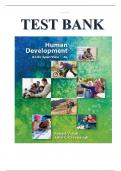..............
, TEST BANK FOR HUMAN DEVELOPMENT: A LIFE-SPAN VIEW 8TH EDITION ROBERT V. KAIL JOHN C. CAVANAUGH
ISBN-10: 1337554839
ISBN-13: 9781337554831
Table Of Contents
1. The Study of Human Development.
Part I: PRENATAL DEVELOPMENT, INFANCY, AND EARLY CHILDHOOD.
2. Biological Foundations: Heredity, Prenatal Development, and Birth.
3. Tools for Exploring the World: Physical, Perceptual, and Motor Development.
4. The Emergence of Thought and Language: Cognitive Development in Infancy and Early Childhood.
5. Entering the Social World: Socioemotional Development in Infancy and Early Childhood.
Part II: SCHOOL-AGE CHILDREN AND ADOLESCENTS.
6. Off to School: Cognitive and Physical Development in Middle Childhood.
7. Expanding Social Horizons: Socioemotional Development in Middle Childhood.
8. Rites of Passage: Physical and Cognitive Development in Adolescence.
9. Moving Into the Adult Social World: Socioemotional Development in Adolescence.
Part III: YOUNG AND MIDDLE ADULTHOOD.
10. Becoming an Adult: Physical, Cognitive, and Personality Development in Young Adulthood.
11. Being With Others: Forming Relationships in Young and Middle Adulthood.
12. Work, Leisure, and Retirement.
13. Making It in Midlife: The Biopsychosocial Challenges of Middle Adulthood.
Part IV: LATE ADULTHOOD.
14. The Personal Context of Later Life: Physical, Cognitive, and Mental Health Issues.
15. Social Aspects of Later Life: Psychosocial, Retirement, Relationship, and Societal Issues.
16. The Final Passage: Dying and Bereavement.
,1. The scientific study of human development can best be described as
*a. multidisciplinary
b. focused on groups rather than individuals
c. non-theoretical
d. emphasizing stability over change
2. Which term does not belong in this group?
a. experiential
b. nurture
c. environmental
*d. hereditary
3. Dr. Kim takes a strong nature position with regard to the origins of intellectual
disabilities. Therefore, she would most likely hypothesize that her son’s intellectu
al disability (formally known as mental retardation) is due to
a. her parenting style
*b. his genes
c. his exposure to a toxic chemical prior to birth
d. his exposure to Rubella prior to birth
4. The notion that development is best described in terms of a series of abrupt s
hifts in behavior best fits with the ____ approach.
a. nature
b. nurture
c. continuity
*d. discontinuity
5.Cleo, a director of a daycare, uses terms like “pre-K,” “K-3,” and the “upper-ele
mentary.” These ideas are most compatible with a ____ view.
a. context-specificity
b. hereditary
, c. continuity
*d. discontinuity
6. Dr. Fletcher is attempting to determine whether adult criminals were rule-break
ers throughout their childhood or whether they suddenly turned to a life of crime.
Her research is most concerned with which issue of human development?
a. nature versus nurture
b. universal versus context-specific development
c. biological versus sociocultural forces
*d. continuity versus discontinuity
7. Mustafa is interested in determining whether children develop virtually the sa
me way in Algeria as they do in other parts of the world. Mustafa’s research deals
primarily with the ____ issue of human development.
a. psychological versus biological forces
*b. universal versus context-specific development
c. nature versus nurture
d. continuity versus discontinuity
8. When Clarisse says, “It doesn’t matter if they are French, Swedish, or Chinese,
kids are kids,” she is espousing a ____ position concerning human development.
a. discontinuous
*b. universal
c. nurture
d. context-specific
9. Viviana notices that children seem to mature socially much faster in Costa Ric
a than in the Canada. Viviana is most likely to support a ____ position regarding h
uman development.
a. nature
b. discontinuous
*c. context-specific





